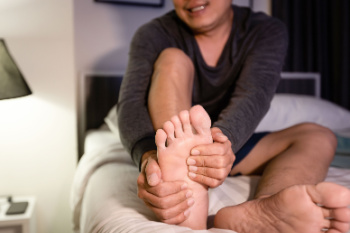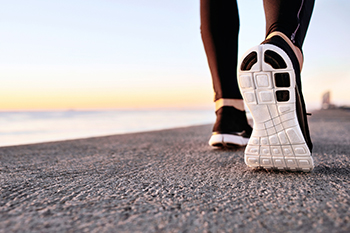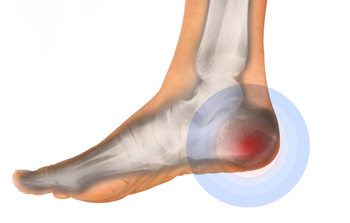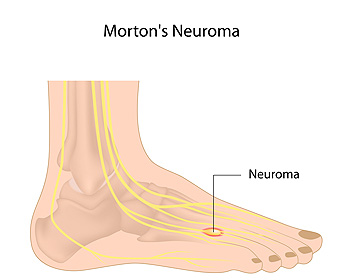Items filtered by date: July 2025
Understanding Plantar Fasciitis Through Time

Plantar fasciitis has likely troubled people since the earliest days of walking long distances on hard terrain, but it was not until the late 19th century that heel pain began to receive medical attention. Early physicians noticed a pattern of foot discomfort among those who stood for extended hours, such as factory workers and soldiers. Still, it took decades before experts connected the discomfort to the plantar fascia. With the rise of sports medicine in the mid-20th century, awareness grew around how repeated stress, shoes lacking adequate support, and foot structure could lead to this painful condition. Over time, care evolved from simple rest to more focused solutions like arch support and soft tissue therapies. Although common, plantar fasciitis remains a condition that benefits from expert guidance. If discomfort in the heel has become persistent, it is suggested you see a chiropodist for care.
Plantar fasciitis can be painful and interfere with your daily activities. If you are experiencing foot or heel pain and believe you may be afflicted with plantar fasciitis, please consult with Cynthia Chan, B.Sc., D.Ch from Healthy Advantage Foot & Orthotic Clinic. Our practitioner will assess your condition and provide you with quality foot and ankle treatment.
What Is Plantar Fasciitis?
Plantar fasciitis refers to the inflammation of the plantar fascia, a ligament that runs along the bottom of the foot and connects the heel bone to the toes. Repetitive activities, such as running or jumping, can injure the plantar fascia over time. Plantar fasciitis can also be caused by flat feet, high arches, pregnancy, and activities that put excessive pressure on your feet, like standing all day for work. When the plantar fascia becomes inflamed, it causes pain and discomfort.
Symptoms
Typical symptoms of plantar fasciitis include:
- Stabbing pain near the heel
- Pain that is worst in the morning or after a period of rest
- Pain that increases after exercising
- Swelling
- Tightness in the Achilles tendon
Diagnosis
Plantar fasciitis is typically diagnosed via medical history and physical examination.
Treatment
Treatments for plantar fasciitis include resting and icing the affected foot, stretching the foot, taking medications to reduce inflammation, and wearing orthotics. In severe cases where pain does not improve with conservative treatments, injections or surgery may be recommended.
If you have any questions, please feel free to contact our office located in . We offer the newest diagnostic and treatment technologies for all your foot care needs.
Running Shoes Versus Walking Shoes

Running shoes and walking shoes are designed with different goals in mind. Running shoes offer more cushioning, flexibility, and support to absorb the higher impact of running. Walking shoes provide stability, a firmer sole, and better arch support for prolonged, low-impact movement. Selecting the wrong type of shoe can lead to discomfort or injury. A chiropodist can assess your gait, foot structure, and activity level to recommend the best footwear for your needs. Whether you are training for a race or taking daily walks, the right shoes matter. If you have sustained a foot or ankle injury from wearing the wrong shoes, it is suggested that you visit a chiropodist who can treat various foot conditions, in addition to ensuring your footwear supports your foot health and overall comfort.
Finding the right shoes can sometimes be a major hassle, especially if you intend to work out in them. There are shoes on the market designed specifically for running and walking, but it can be difficult to differentiate between the two and find the right shoes for you. If you’re having trouble finding the right shoes, please consult with Cynthia Chan, B.Sc., D.Ch from Healthy Advantage Foot & Orthotic Clinic. Our practitioner can help you maintain the health of your lower limbs and your mobility.
What are the differences between running and walking shoes?
These two types of shoes vary along several parameters.
- Cushioning: Runners need more cushioning in the heel and forefoot areas of the shoe, while walkers can get away with less cushioning.
- Heel height: Runners need a higher heel to provide them with stability, but the ideal height of the heel for runners varies depending on their running gait. Walkers generally don’t need a built-up heel.
- Heel flare: Flared heels can help provide extra stability for runners with certain gaits, while walkers may benefit from a flared heel to control the motion of their foot.
- Flexibility: Both runners and walkers need shoes that are flexible.
For more information about the differences between walking and running shoes, and to figure out which shoes may be right for you, please consult with a chiropodist. Feel free to contact our office located in . We offer the newest diagnostic and treatment technologies for all your foot care needs.
Why Heel And Rearfoot Pain Is Common in Older Adults

Discomfort in the heel or back of the foot often becomes more noticeable with age. Over time, the tissues that support the foot can weaken or lose flexibility, making the area more prone to irritation. A frequent cause is strain where the Achilles tendon connects to the heel, which can lead to stiffness and soreness during walking or standing. Reduced padding under the heel and changes in foot shape may also contribute to pain. Joint conditions such as arthritis, years of wear on the feet, or the effects of long-term use of unsupportive shoes can add to the problem. Even simple activities like getting out of bed or walking short distances may become uncomfortable, if the issue is not addressed. If you are noticing continued soreness or stiffness in the heel or back of the foot, it is suggested that you see a chiropodist for a thorough evaluation and appropriate care plan.
Heel pain is a common problem that can be caused by a variety of injuries, medical conditions, and other factors. If you suffer from heel pain, please consult with Cynthia Chan, B.Sc., D.Ch from Healthy Advantage Foot & Orthotic Clinic. Our practitioner can help you maintain the health of your lower limbs and your mobility.
When it comes to heel pain, the exact location and type of pain are important to note. Some of the conditions that may cause heel pain include:
- Plantar fasciitis - An inflammation of the ligament that runs along the bottom of the foot; it causes a stabbing pain under the heel that is at its worst when taking your first few steps after a long rest and while standing on your tiptoes or climbing stairs
- Achilles tendonitis - An inflammation of the tendon in the back of the calf; it causes pain in the back of the heel that is at its worst after resting, as well as ankle and calf stiffness, swelling, and tenderness
- Bone spurs - Bony lumps on the back of the heel bones that cause sharp pain upon first standing up; the pain becomes dull and achy over time
- Heel fractures - A break or crack in the heel bone that causes pain, swelling, and difficulty walking
- Retrocalcaneal bursitis - Swelling of the small, fluid-filled sac at the back of the heel bone; it causes pain, swelling, redness, and warmth in the back of the heel
- Tarsal tunnel syndrome - Compression of the posterior tibial nerve which causes a pins and needles sensation in the heel, foot, and calf
Your chiropodist will be able to diagnose the underlying cause of your pain and prescribe the right treatments for you. If you have any questions, please feel free to contact our office located in . We offer the newest diagnostic and treatment technologies for all your foot care needs.
Morton’s Neuroma and Forefoot Pain

Morton’s neuroma is a painful condition that affects the ball of the foot, most often between the third and fourth toes. It involves the thickening of tissue around a nerve leading to the toes, which can cause sharp, burning pain or the sensation of standing on a small pebble. Some people also feel tingling or numbness in the toes. Wearing tight shoes, high heels, and repetitive pressure from activities like running can contribute to this condition. It tends to affect women more than men. Treatment often begins with footwear changes, orthotics to reduce pressure, and activity modifications. In some cases, steroid injections or other medical procedures may be recommended. Early care can prevent the condition from worsening and reduce the need for more invasive treatments. If you have persistent forefoot pain or suspect a neuroma, it is suggested that you schedule an appointment with a chiropodist for an accurate diagnosis and appropriate treatment.
Morton's neuroma can be highly uncomfortable. If you are experiencing the symptoms of Morton's neuroma, please consult with Cynthia Chan, B.Sc., D.Ch from Healthy Advantage Foot & Orthotic Clinic. Our practitioner will assess your condition and provide you with quality foot and ankle treatment.
What Is a Morton’s Neuroma?
Morton’s neuroma is a condition in which a nerve located in the ball of the foot between the third and fourth toes thickens due to compression or irritation. Common causes of Morton’s neuroma include wearing shoes with high heels or narrow toe boxes, participating in running or court sports, an injury or trauma to the area, or pressure being placed on the nerve from foot deformities such as bunions or hammertoes. Left untreated, Morton's neuroma may result in permanent nerve damage.
Symptoms
Symptoms of Morton’s neuroma often start gradually and worsen over time. Typical symptoms include:
- Foot pain
- Tingling, burning, or numbness in the affected foot
- The unique sensation that something is inside the ball of the foot or that there is something stuck in your shoe while walking
Treatment
Non-surgical treatments for this condition may include padding or icing the affected foot, wearing an orthotic device, modifying activities or shoes to reduce pressure on the foot, and taking medications or getting injections to reduce pain and inflammation. Surgery may be needed if non-surgical treatments are ineffective.
If you have any questions, please feel free to contact our office located in . We offer the newest diagnostic and treatment technologies for all your foot care needs.
Are Bunions Affecting Your Everyday Life?
Common Injuries Caused by Running

Running regularly places repeated stress on the feet and ankles, which can lead to a range of injuries if warning signs are ignored. Common causes of foot pain in runners include plantar fasciitis, which causes stabbing pain under the heel, and Achilles tendinopathy, marked by soreness above the back of the heel, especially after activity. Runners are also at risk for ankle sprains, stress fractures in bones such as the metatarsals, and posterior tibial tendon dysfunction, which may flatten the foot over time. Pain in the ball of the foot, known as metatarsalgia, often results from overloading the front of the foot during runs. Morton’s neuroma, a nerve issue between the toes, can cause tingling or a burning sensation. Heel bursitis leads to swelling behind the heel, and repetitive toe pressure may cause bruised toenails or runner’s toe. If you experience foot pain after running, it is suggested that you schedule an appointment with a chiropodist for expert advice.
Although running is a wonderful exercise to keep you in shape, it can wreak havoc on your feet and ankles if you don’t take preventive measures. If you have sustained a foot and ankle injury from running, please consult with Cynthia Chan, B.Sc., D.Ch from Healthy Advantage Foot & Orthotic Clinic. Our practitioner can help you maintain the health of your lower limbs and your mobility.
Some common running injuries include:
- Achilles tendonitis
- Shin splints
- Ankle sprains
- Stress fractures
- Plantar fasciitis
- Bursitis
What causes injuries?
These injuries are usually caused by overtraining, wearing the wrong shoes, running on hard surfaces, having tight and inflexible muscles, or having biomechanical issues in the feet or ankles.
What can I do to prevent injuries?
- Train slowly and gradually
- Give yourself plenty of time to recover following a run
- Wear shoes that fit properly and support your foot
- Avoid running on hard surfaces, like concrete
- Stretch and strengthen the muscles of your lower legs
- Warm-up prior to a run
- Have your gait analyzed and your feet examined by a chiropodist to determine if there are any biomechanical problems that need to be treated
If you have any questions, please feel free to contact our office located in . We offer the newest diagnostic and treatment technologies for all your foot care needs.
